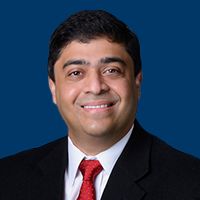Article
Clinical Trials Aim to Bring Zenocutuzumab to Patients with NRG1+ Cancers
Author(s):
Blocking ligand interaction of HER2 and HER3 in patients with NRG1 fusion–positive tumors has demonstrated a clinically feasible avenue to improve outcomes with the novel agent zenocutuzumab.
Elena Garralda, MD, MSc

Blocking ligand interaction of HER2 and HER3 in patients with NRG1 fusion–positive tumors has demonstrated a clinically feasible avenue to improve outcomes with the novel agent zenocutuzumab (MCLA-128). By targeting these surface receptors using the “dock and block” approach, investigators have demonstrated the novel bispecific antibody has activity in several tumor types, including for patients with non–small cell lung cancer (NSCLC).1,2
Although incidence of NRG1 fusions is only 0.2% across cancers, most are identified in lung cancers including NSCLC and the invasive mucinous adenocarcinoma subtype.3 Because of the rarity of NRG1 fusions, the global eNRGy1 registry was established to identify the fusion among patients with lung cancer.4 As testing for patients with NSCLC increases to identify actionable markers, the identification of NRG1 fusions may also experience an uptick with RNA sequencing, making agents with demonstrable activity of need.
eNRGY and Early Access Trials Demonstrate Durability, Safety of Zenocutuzumab
Early preclinical studies of zenocutuzumab demonstrated that patient-derived and isogenic cell lines expressing NRG1 fusions demonstrated high sensitivity in lung cancer cell lines.5
Thoracic malignancies represent just 1 histology harboring NRG1 fusions in need of therapeutic options. As such, investigators of the phase 1/2 eNRGy trial (NCT02912949) are enrolling patients with NRG1 fusion–positive tumors globally.6,7 For those who are ineligible for an ongoing clinical trial or have difficulties accessing a site because of barriers such as geography, the agent’s developer, Merus N.V., has an early access program (NCT04100694), which is providing single patient/named access to zenocutuzumab.
The inclusion criteria for the studies require that patients have locally advanced, unresectable, or metastatic solid tumors with confirmed NRG1 positivity. They must have been previously treated or ineligible for standard therapy; be age 18 years or older; and have an ECOG performance status between 0 and 2.
Patients are administered zenocutuzumab at 750 mg intravenously once every 2 weeks until progressive disease, with tumor assessments occurring every 8 weeks, and survival follow-up for up to 2 years. The primary end point is overall response rate (ORR) per investigator assessment using RECIST criteria, with duration of response (DOR), ORR per central review, safety, pharmacokinetics, and antidrug antibody assessment serving as secondary outcomes.1,6,7
As of April 12, 2022, data cutoff, 110 patients were enrolled across 64 sites in 17 countries. For inclusion in the primary analysis, participants had to have received at least 1 dose of zenocutuzumab, had the opportunity for at least 6 months follow-up by data cutoff, and met criteria for primary efficacy population.
Data presented at the 2022 American Society of Clinical Oncology (ASCO) Meeting showed that primary analysis population included 83 patients who had enrolled either through a clinical trial site (n = 72) or obtained early access to the bispecific (n = 11). Forty-seven patients had NSCLC, 19 had pancreatic ductal adenocarcinoma, and the remaining patients had breast, cholangiocarcinoma, colorectal cancer, or other histologies.1
At a median follow-up of 6.3 months, the HER2 × HER3 bispecific antibody elicited an investigator-assessed ORR of 34% (95% CI, 24%-46%) by RECIST 1.1 criteria among all patients analyzed (n = 79), with a median time to response of 1.8 months, and a median DOR of 9.1 months (95% CI, 7.4-not reached).1 Fifty-five patients had tumor shrinkage (70%). Among responders, the estimated 6-month response rate was 76% with a 12-month response rate of 27%.
Among the 46 patients with NSCLC, the ORR was 35% (95% CI, 21%-50%). In an updated case report of a man aged 84 years with SLC3A2 NRG1 fusion–positive NSCLC with metastatic disease in the lungs and lymph nodes was not eligible for chemoimmunotherapy. He was treated with zenocutuzumab and had a rapid response. With 8 additional cycles of follow-up, the patient had ongoing partial response nearly 16 months into treatment, with a tumor reduction of 38%.1
In addition to durable responses, pharmacokinetic data demonstrated that the agent has a half-life of approximately 4 days with greater than 95% predicted receptor occupancy for HER3 and HER2 throughout the dosing interval.1
Most toxicities with zenotuzumab were low grade with less than 1% of patients discontinuing treatment due to an adverse event.1
During the 2022 ASCO meeting, invited discussant Elena Garralda, MD, MSc, of the Vall d’Hebron Institute of Oncology, described zenocutuzumab as a “tale of firsts.”
“[eNRGy] is the first clinical trial to evaluate prospectively the role of ERBB3 inhibition in NRG1- positive tumors. I want to highlight the high recruitment, since [the 2021 ASCO meeting]: 49 patients. This speaks about the importance, the need, and the feasibility of performing studies in low prevalence tumor indications,” Garralda said.
“[Zenocutuzumab] has the first breakthrough therapy designed by the FDA for NRG1-positive tumors.8 It’s the first time we are targeting a ligand. And it’s the first time we are doing it through an antibody that targets it in an indirect way. Bispecifics hold the promise of extending the possibilities of monoclonal antibody therapeutics.”
As investigative efforts continue with zenocutuzumab, key considerations include the prognostic role of NRG1 fusions. “There is evidence that in NRG1 [fusion–positive] NSCLC, patients appear to respond less to other therapies. We need to establish these to fully understand the value of targeting NRG1… and we need to understand brain activity, which is particularly relevant in NSCLC,” she said.
RNA-based Testing for NRG1 Is Key
In terms of testing for NRG1 fusions, the eNRGy1 registry report noted that the most common method was RNA sequencing with 74% of cases (n = 81) detected. Among RNA-based assays, the amplicon-based RNA sequencing using anchored multiplex PCR identified 62% of fusions, reverse transcription PCR identified 27%, and expression analysis using nCounter identified 11%. For DNA-based sequencing which was used for 26% of cases (n = 29), next-generation sequencing (NGS) and fluorescence in situ hybridization were nearly equal in their detection rates at 52% and 48%, respectively. Investigators noted that hybrid capture–based testing was used for nearly all NGS tests (93%).4
“RNA-based assays appear to be the best molecular testing method to identify NRG1 fusions,” Drilon et al wrote in the findings from eNRGy1 registry.4 “NRG1 fusion breakpoints, [although] highly heterogenous as demonstrated here, convergently occur in large intronic regions that are challenging to tile and capture by DNA-based assays.”
Additionally, in the data presented at the 2022 ASCO Annual Meeting, Garralda concurred adding that in the eNRGy study, “Of the 83 patients that were presented, 64 were identified based on RNA. And this is important. If we want to look for these fusions, we are going to need to be using RNA based sequencing methods.”1
References
- Schram AM, Goto K, Kim DW, et al. Efficacy and safety of zenocutuzumab, a HER2 x HER3 bispecific antibody, across advanced NRG1 fusion (NRG1+) cancers. J Clin Oncol. 2022;40(suppl 16):105. doi:10.1200/JCO.2022.40.16_suppl.105
- Geuijen CAW, De Nardis C, Maussang D, et al. Unbiased combinatorial screening identifies a bispecific IgG1 that potently inhibits HER3 signaling via HER2-guided ligand blockade. Cancer Cell. 2021;39(8):1163-1164. doi:10.1016/j.ccell.2021.07.015
- Drilon A, Somwar R, Mangatt BP, et al. Response to ERBB3-directed targeted therapy in NRG1-rearranged cancers. Cancer Discov. 2018;8:686-695. doi:10.1158/2159-8290.CD-17-1004
- Drilon A, Duruisseaux M, Han JY, et al. Clinicopathologic features and response to therapy of NRG1 fusion–driven lung cancers: the eNRGy1 global multicenter registry. J Clin Oncol. 2021;39(25): 2791-2802. doi:10.1200/JCO.20.03307
- Schram AM, Odintsov I, Espinosa-Cotton M, et al. Zenocutuzumab, a HER2xHER3 bispecific antibody, is effective therapy for tumors driven by NRG1 gene rearrangements. Cancer Discov. 2022;12(5):1233-1247. doi:10.1158/2159-8290.CD-21-1119
- A study of zenocutuzumab (MCLA-128) in Patients with solid tumors harboring an NRG1 fusion (eNRGy). ClinicalTrials.gov. Updated August 12, 2022. Accessed September 21, 2022. https://clinicaltrials.gov/ct2/show/NCT02912949
- Early access program providing HER2/HER3 bispecific antibody, MCLA-128, for a patient with advanced NRG1-fusion positive solid tumor. ClinicalTrials.gov. Updated July 28, 2021. Accessed September 21, 2022. https://clinicaltrials.gov/ct2/show/NCT04100694
- Merus granted FDA fast track designation of zenocutuzumab for the treatment of patients with neuregulin 1 fusion cancers. News release. Merus NV. January 7, 2021. Accessed September 21, 2022. bit.ly/3bobmtY








